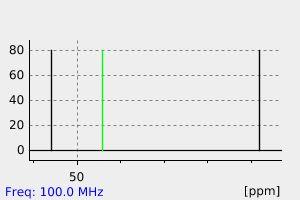2-(N-吗啉)乙烷磺酸 | 1912-28-3
中文名称
2-(N-吗啉)乙烷磺酸
中文别名
2-(N-吗啉)乙烷磺酸
英文名称
methyl ethanesulfonate
英文别名
ethanesulfonic acid methyl ester;Aethansulfonsaeure-methylester;methyl ethyl sulfonate;Aethansulfonsaeuremethylester;Ethansulfonsaeure-methylester;Methyl ethansulfonat;Ethanesulfonic acid, methyl ester
CAS
1912-28-3
化学式
C3H8O3S
mdl
——
分子量
124.161
InChiKey
YLJRCXSSKLWCDE-UHFFFAOYSA-N
BEILSTEIN
——
EINECS
——
-
物化性质
-
计算性质
-
ADMET
-
安全信息
-
SDS
-
制备方法与用途
-
上下游信息
-
文献信息
-
表征谱图
-
同类化合物
-
相关功能分类
-
相关结构分类
物化性质
-
沸点:214℃
-
密度:1.177
-
闪点:84℃
-
溶解度:可溶于氯仿(少量)、甲醇(少量)
计算性质
-
辛醇/水分配系数(LogP):0
-
重原子数:7
-
可旋转键数:2
-
环数:0.0
-
sp3杂化的碳原子比例:1.0
-
拓扑面积:51.8
-
氢给体数:0
-
氢受体数:3
安全信息
-
危险等级:IRRITANT
-
危险品标志:Xi
-
安全说明:S26,S36
-
危险类别码:R36/37/38
-
WGK Germany:1,3
-
海关编码:2905199090
SDS
制备方法与用途
甲酯乙磺酸甲酯可作为有机合成中间体和医药中间体,主要应用于实验室研发和化工生产过程中。
上下游信息
-
上游原料
中文名称 英文名称 CAS号 化学式 分子量 乙基磺酸 ethanesulfonic acid 594-45-6 C2H6O3S 110.134
反应信息
-
作为反应物:描述:参考文献:名称:Gilman; Robinson, Bulletin de la Societe Chimique de France, 1929, vol. <4> 45, p. 640摘要:DOI:
-
作为产物:参考文献:名称:Padmapriya, A. A.; Just, G.; Lewis, N. G., Synthetic Communications, 1985, vol. 15, # 12, p. 1057 - 1062摘要:DOI:
文献信息
-
Solvent and Steric Effects on the Solvolysis of Polyvinylsulfonic Acid Esters作者:Sadao Yoshikawa、Oh-Kil Kim、Takeshi HoriDOI:10.1246/bcsj.39.1937日期:1966.9which contributed to the initial rate enhancement, while the latter indicates the aggregation of the polymer molecules owing to their strong hydrophobic character. The solvolysis rates, kp, for polymeric sulfonic esters were much greater than those, km, for monomeric analogs in all cases except isopropyl and n-butyl esters in 20% aqueous acetone. The relative rate (kp/km) increased with an increase
-
Studies on chemical carcinogens and mutagens. XXV. Chemoselectivity of alkyl sulfonates toward 4-(p-nitrobenzyl)pyridine (NBP) in phosphate buffer.作者:SHINICHI NINOMIYA、KOHFUKU KOHDA、YUTAKA KAWAZOEDOI:10.1248/cpb.32.1326日期:——Methyl, ethyl, and isopropyl esters of six alkanesulfonic acids and five p-substituted benzenesulfonic acids were synthesized and their alkylating abilities were evaluated in terms of the chemoselectivity toward 4-(p-nitrobenzyl) pyridine (NBP) in phosphate buffer (pH 6.0) containing 60% acetone. The chemoselectivity constant toward NBP, SNBP, was defined as the logarithm of the ratio of the molar fraction of an alkylating sulfonate which is consumed for alkylation of NBP versus the molar fraction of the residual alkylating agent which is hydrolyzed in the buffer medium. It was found that SNBP was not only markedly dependent on the structure of the alkyl moiety of the molecule, but also appreciably dependent on the electronic nature of the leaving sulfonic acid moiety. The structure-chemoselectivity relationship is discussed.
-
Sequence dependence of methylation rate enhancement in meta-phenyleneethynylene foldamers作者:Ronald A. Smaldone、Jeffrey S. MooreDOI:10.1039/b716122k日期:——The methylation rates of a meta-phenyleneethynylene (mPE) oligomer with a terminally-attached 4-dimethylaminopyridine (DMAP) residue are reported for a series of linear and branched methyl sulfonates; these data show that selective methylation is enhanced by locating the DMAP unit at the midpoint of the sequence, allowing the foldamer cavity to function as a reactive sieve.
-
Shipov, A. G.; Baukov, Yu. I., Journal of general chemistry of the USSR, 1984, vol. 54, # 8, p. 1642 - 1657作者:Shipov, A. G.、Baukov, Yu. I.DOI:——日期:——
-
Foldamers as Reactive Sieves: Reactivity as a Probe of Conformational Flexibility作者:Ronald A. Smaldone、Jeffrey S. MooreDOI:10.1021/ja067670a日期:2007.5.1A series of m-phenyleneethynylene (mPE) oligomers modified with a dimethylaminopyridine (DMAP) unit were treated with methyl sulfonates of varying sizes and shapes, and the relative reactivities were measured by UV spectrophotometry. Using a small-molecule DMAP analogue as a reference, each of the methyl sulfonates was shown to react at nearly identical rate. In great contrast, oligomers that are long enough to fold, and hence capable of binding the methyl sulfonate, experience rate enhancements of 18-1600-fold relative to that of the small-molecule analogue, depending on the type of alkyl chain attached to the guest. Three different oligomer lengths were studied, with the longest oligomers exhibiting the fastest rate and greatest substrate specificity. Even large, bulky guests show slightly enhanced methylation rates compared to that with the reference DMAP, which suggests a dynamic nature to the oligomer's binding cavity. Several mechanistic models to describe this behavior are discussed.
表征谱图
-
氢谱1HNMR
-
质谱MS
-
碳谱13CNMR
-
红外IR
-
拉曼Raman
-
峰位数据
-
峰位匹配
-
表征信息
同类化合物
高烯丙基(甲磺酰基)胺
高炔丙基(甲磺酰基)胺
顺式-9-十八碳烯基甲烷磺酸酯
顺式-4-乙基环己基甲烷磺酸酯
顺-1,2-双(甲磺酰基氧基甲基)环己烷
阿坎酸杂质
阿坎酸
锌甲烷磺酸盐
铵磺酸甜菜碱-3
铵磺酸甜菜碱-2
铵磺酸甜菜碱-1
铬雾抑制剂
铁三(三氟甲基磺酰基)亚胺
钾3-(三羟基硅烷基)-1-丙烷磺酸酯
钾1,1,2,2,3,3,4,4-八氟丁烷-1-磺酸盐
钡二乙烷磺酸酯
钠3-氨基丙烷磺酸酯
钠3-氨基-3-氧代-丙烷-1-磺酸酯
钠3-(三羟基硅烷基)-1-丙烷磺酸酯
钠2-[2-[2-[2-[2-[2-[2-[2-[2-[2-(2-十八碳-9-烯氧基乙氧基)乙氧基]乙氧基]乙氧基]乙氧基]乙氧基]乙氧基]乙氧基]乙氧基]乙氧基]-2-氧代-乙烷磺酸酯
钠1-羟基-1-庚烷磺酸酯
钠(1E)-1-十二碳烯-1-磺酸酯
酪朊酸钠
辛烷-1-磺酸甲酯
辛烷-1-磺酸乙酯
辛基-1-磺酸戊酯
辛-2-烯-1-磺酸
辅酶 M
西尼必利杂质7
萘-1,8-二甲醇
英丙舒凡对甲苯磺酸盐
英丙舒凡
苯基硒基三氟甲烷磺酸酯
芥酸酰胺丙基羟基磺基甜菜碱
艾日布林中间体
脒基牛磺酸
胺磺酸甜菜碱-4
联硫亚盐氯乙醛钠水合物
羧基-五聚乙二醇-磺酸
羟甲基磺酸钠
羟基甲烷磺酸铵盐
羟基甲烷磺酸钾
羟基甲氧基甲醇甲磺酸酯
羟乙磺酸钾
羟乙基磺酸铵盐
羟乙基磺酸钠
羟丙基硫代硫酸钠
美司那
磺酸钠
磺酸己烷








